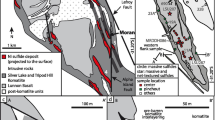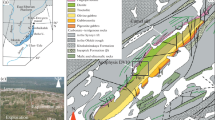Summary
A volumetrically minor Cu−Fe−Ni−S component derived from the uppermost mantle is found within the Beni Bousera (northern Morocco) and Ronda (southern Spain) “Alpine”-type peridotites; it occurs today as inclusions within primary silicates or as assemblages disseminated in the intergranular sites of the host rocks. Detailed microtextural and microprobe data indicate that inclusions and intergranular assemblages behaved as two contrasting systems during the low temperature, incipient serpentinization of the host rocks. The former were equilibrated in closed systems whereas the latter behaved as open systems with respect to hydrothermal fluids; as a result, intergranular assemblages were controlled by redox conditions generated by serpentinization. An early stage of alteration is characterized by a slight decrease of the sulfur content and would be due to the first influx of water inside peridotites; a further transformation was produced by anomalous highly reducing conditions responsible for the crystallization of native iron-bearing alloy assemblages as well as for a preferential partioning of Fe from silicate into pentlandite. The production of anomalous, reducing conditions during incipient serpentinization is ascribed to a low permeability of the host rocks with respect to the diffusion of hydrogen out of the sites of serpentinization. Because of its low temperature behaviour, the intergranular sulfide component would not be of use reconstructing the initial composition of the upper mantle sulfide component; thus, it is concluded that only the sulfide inclusions would provide such informations.
Résumé
Des traces d'un composant sulfuré du système Cu−Fe−Ni−S d'origine mantellique sont présentes dans les péridotites “alpines” de Beni Bousera (Maroc) et Ronda (Espagne); il forme actuellement des inclusions dans les silicates primaires ou des plages intergranulaires disséminées dans les interstices des roches. Une analyse minéralogique et chimique détaillée démontre qu'inclusions et plages intergranulaires sulfurées ont eu un comportement opposé dès les premiers stades de serpentinisation des roches encaissantes. Les premières ont été reéquilibrées en système chimique ouvert vis-à-vis des fluides de serpentinisation; en conséquence les paragenèses intergranulaires résultent d'une suite de transformations du composant sulfuré mantellique, controlée par le degré d'oxydo réduction du fluide de serpentinisation. Dans un premier stade, l'entrée de l'eau dans les péridotites a provoqué une légère baisse de la fugacité du soufre et la cristallisation d'assemblages sulfurés riches en mackinawite. L'augmentation du degré de serpentinisation a ensuite engendré des conditions inhabituellement réductrices responsables d'un important fractionnement du fer libéré par la serpentinisation de l'olivine dans la pentlandite ainsi que de la cristallisation d'une paragenèse complexe de phases métalliques incluant localement le fer natif; ces conditions anormalement reductrices sont imputées à une faible perméabilité des roches encaissantes vi-à-vis de la diffusion de l'hydrogène en dehors dessites de serpentinisation. En raison de leur comportement à basse température, les plages sulfurées intergranulaires sont inutilisables pour reconstituer le composant sulfuré du manteau supérieur; sur ce plan, on conclut que seules les inclusions blindées dans les silicates peuvent apporter des informations.
Similar content being viewed by others
References
Abrajano, T. A., Pasteris, J. D., 1984: The stabilization of native iron and iron-alloys (NIIA) during hydratation of ultramafic rocks. E.O.S.65, 1123.
Ahmed, Z., Hall, A., 1982: Nickeliferous opaque minerals associated with chromite alteration in the Sakhakot Qila complex, and their compositional variation. Lithos15, 39–47.
Ashley, P. M., 1975: Opaque mineral assemblages formed during serpentinization in the Coolac ultramafic belt, New South Wales. J. Geol. Soc. Australia22, 320–326.
Barrakad, A., 1971: Mauchérite et cuivre natif dans les Beni Bousera (Rif Maroc). Notes Serv. geol. Maroc.31, no 237, 285–288.
Besson, M., 1975: Les sulfures des lherzolites et ariègites. Bull. Soc. Fr. Min. Crist.98, 53–44.
Blain, J. C., 1978: Hydrothermal nickelian mackinawite in nickel mineralization at Wadi Qatan, Saudi Arabia. Min. Mag.42, 284–286.
Botto, R. J., Morrison, C. H., 1976: Josephinite: a unique nicke-iron. Amer. J. Sci.276, 241–274.
Chamberlain, J. A., MacLeod, G. R., Trail, J., Lachance, G. R., 1965: Native metals in the Muskox intrusion. Canad. J. Earth Sci.2, 188–215.
Conquéré, F., 1969: A propos d'un nouveau gisement de mackinawite nickélifère. C.R. Acad. Sci. Paris269, 1919–1921.
—,Kornprobst, J., 1972: Quelques précisions sur les caractères minéralogiques et chimiques des pyroxènolites à grenat des Beni Bousera. Bull. Soc. Fr. Min. Crist.95, 115–123.
Eckstrand, O. R., 1975: The Dumont serpentinite: a model for control of nickeliferous opaque mineral assemblages by alteration reactions in ultramafic rocks. Econ. Geol.70, 183–201.
Garuti, G., Gorgoni, C., Sighinolfi, G. P., 1984: Sulfide mineralogy and chalcophile and siderophile element abundances in the Ivrea-Verbano mantle peridotites (western Italian Alps). Earth Planet. Sci. Lett.70, 69–87.
Golightly, J. P., Arancibia, O. N., 1979: The chemical composition and infrared spectrum of nickel and iron-substitued serpentine from a nickeliferous laterite profile. Soroko, Indonesia. Canad. Min.17, 719–729.
Groves, D. I., Keays, R. R., 1979: Mobilization of ore-forming elements during alteration of dunites, Mt. Keith Betheno, western Australia. Canad. Min.17, 373–389.
Kanehira, K., Banno, S., 1964: Finding of awaruite (native nickel-iron) from serpentinites near the city of Koti, Shikoku, Japan. J. Geol. Soc. Japan20, 272–277.
Kornprobst, J., 1969: Le massif ultrabasique de Beni Bouchera (Rif Interne, Maroc). Étude des péridotites de haute température et de haute pression et des pyroxènites à grenat et sans grenat qui leur sont associées. Contr. Min. Petrol.23, 283–322.
Kornprobst, J., Vielzeuf, D., 1984: Transcurrent crustal thinning: a mechanism for the uplift of deep continental crust — upper mantle associations. In: Kimberlites: the Mantle and Crust Relationships. Developments in petrology 11A (Kornprobst, J., ed.), pp. 347–359. Elsevier.
Kullerud, G., Yund, R. A., Moh, G., 1969: Phase relations in the Cu−Fe−S, Cu−Ni−S and Fe−Ni−S systems. In: Magmatic Ore Deposits, Monog. 4, Econ. Geol., 323–343.
Lorand, J. P., 1983a: Les minéraux opaques des lherzolites à spinelles et des pyroxènites associées: une étude comparative dans les complexes orogéniques et dans les enclaves des basaltes alcalins. Thèse Paris (unpublished).
—, 1983b: Immiscible sulfide in spinel-lherzolite bodies. Some precisions about uppermost mantle metallogeny. Terra Cognita3, 174–175.
—,Pinet, M., 1983: Sur la présence de fer natif et de wairauite (FeCo) dans les péridotites serpentinisées du massif ultramafique de Ronda (Cordillière Betique, Espagne du Sud). C.R. Acad. Sci. Paris, Ser. D297, 501–504.
——, 1984: L'orcelite des péridotites de Ronda (Espagne), Beni Bousera (Maroc), Table Mountain et Blow-Me-Down Mountain (Terre Neuve) et du Pinde Septentrional (Grèce). Canad. Min.22, 553–560.
Mikhailov, N. P., 1975: Données nouvelles sur la pétrologie et la structure interne du massif ultramafique des Beni Bouchera (Rif Paleozoique, Maroc du Nord). Mines et Géologie38, 31–42.
Misra, K., Fleet, M. E., 1973: The chemical composition of synthetic and natural pentlandite assemblages. Econ. Geol.68, 518–539.
Moody, J. B., 1976: Serpentinization: a review. Lithos9, 126–138.
Morimoto, N., Koto, K., 1970: Phase relations in the Cu−Fe−S system at low temperatures: stability of anilite. Amer. Min.55, 106–117.
Naldrett, A. J., Kullerud, G., 1967: The Strathcona mine and nickel-copper ores; Sudbury district. J. Petrol.8, 493–529.
Obata, M., 1980: The Ronda peridotite: garnet-spinel and plagioclase lherzolite facies in the P-T trajectories of the high temperature intrusion. J. Petrol.21, 533–572.
Philippidis, A., 1982: Experimental study of the serpentinization of Mg−Fe−Ni olivine in the presence of sulfur. Canad. Min.20, 567–574.
Power, C. F., Fine, H. A., 1976: The iron-sulfur system. Part 1: structure and physical properites of the compounds of the low temperature phase field. Min. Sci. Eng.8, 106–126.
Ramdohr, P., 1967: A widespread mineral association connected with serpentinization with notes on some new or insufficiently defined minerals. N. Jb. Min., Abt.107, 241–265.
Roseboom, E. H., 1966: An investigation of the Cu−S system and some natural copper sulfides between 25° and 700°C. Econ. Geol.61, 641–672.
Sinton, J. M., 1976: Compositional relationship of the Fe−Ni alloy and coexisting phases in serpentinites. Red Mountain, New Zealand. Min. Mag.40, 792–794.
Sweeney, R. E., Kaplan, I. R., 1973: Pyrite framboid formation; laboratory synthesis and marine sediments. Econ. Geol.68, 618–634.
Wicks, F. H., Whittaker, E. J. W., 1977: Serpentine textures and serpentinization. Canad. Min.15, 458–489.
—,Plant, A. G., 1979: Electron microprobe and X-ray microbeam studies of serpentine textures. Canad. Min.17, 785–831.
Yund, R. A., Hall, H. T., 1970: Kinetics and mechanisms of pyrite exsolution from pyrrhotite. J. Petrol.11, 381–404.
Zoka, H., Taylor, S., Takeno, S., 1973: Compositional variations in natural mackinawite and the results of heating experiments. J. Sci. Hiroshima Univ. Serv.7, 37–53.
Author information
Authors and Affiliations
Additional information
With 9 Figures
Rights and permissions
About this article
Cite this article
Lorand, J.P. The behaviour of the upper mantle sulfide component during the incipient alteration of “Alpine”-type peridotites as illustrated by the Beni Bousera (northern Morocco) and Ronda (southern Spain) ultramafic bodies. TMPM Tschermaks Petr. Mitt. 34, 183–209 (1985). https://doi.org/10.1007/BF01082961
Received:
Accepted:
Issue Date:
DOI: https://doi.org/10.1007/BF01082961




